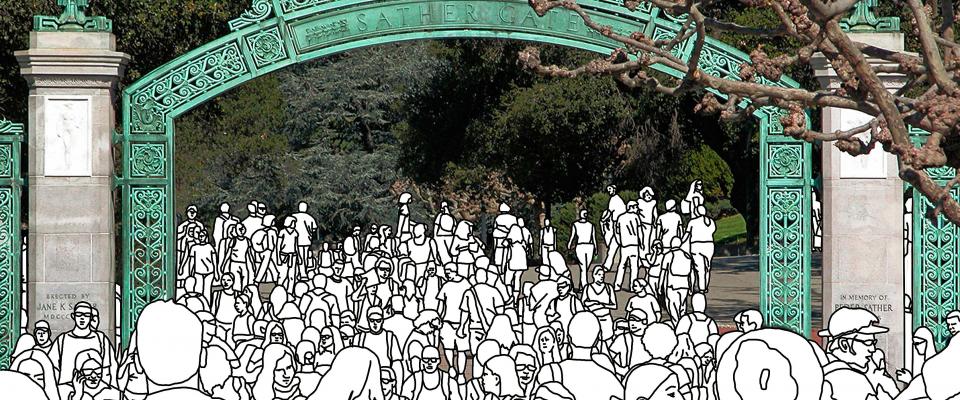Over the past four decades, the issue has simmered under the surface, occasionally boiling over into lawsuits and federal complaints.
That issue is Asian-American enrollment at elite universities.
Percentagewise, Asian Americans are well represented, if not “overrepresented,” at UC Berkeley and other highly selective universities across the country when compared with the general population: Asians/Pacific Islanders are 14.6 percent of California’s population and a little over 5.5 percent of the U.S. population, but they make up 40.8 percent of Cal’s entering freshman class (not including international students). At Stanford and the Ivy Leagues, Asian-American freshmen enrollment generally hovers between 15 and 22 percent.
By contrast, other minority groups are woefully underrepresented at the state’s flagship public university. Take Latinos: The group now makes up nearly 40 percent of California’s population but less than 14 percent of Berkeley’s incoming freshman class. And since the 1996 passage of Proposition 209 (which prohibits California public institutions from considering race, ethnicity, or sex in admissions), black admissions have fallen by over half, to a little over 3 percent.
Yet despite their strong numbers, many Asian Americans feel they are being discriminated against in college admissions at private universities—and they fear that if Prop. 209 is overturned, as has been proposed, they will see their numbers diminish at Berkeley and other elite public universities in California. Indeed, some academics have argued that, judging by grade point averages and standardized test scores alone, they’re right: Many more Asian Americans should be admitted into top-notch universities than currently are.
In his book No Longer Separate, Not Yet Equal: Race and Class in Elite College Admissions and Campus Life, Princeton sociologist Thomas J. Espenshade examined admissions data from ten colleges. One of his most-cited findings is that in fall 1997, Asian Americans needed to score about 140 points higher on their SATs (out of 1,600) than white students, and 450 points higher than African-American students—all others things being equal—to have the same chance of being admitted into an elite private university.
Espenshade has repeatedly said, however, that his data do not “prove” Asian Americans are discriminated against, because he doesn’t have access to other variables such as essays, letters of recommendation, and extracurricular activities. In a 2012 opinion piece for The New York Times, Espenshade wrote that he believes “race-conscious affirmative action is necessary, and often beneficial.” He also wrote, however, that “Race-based affirmative action has been a woefully inadequate weapon in the arsenal against inequality. It treats the symptoms but not the root causes of an underlying social problem.”
Those arguments aside, many Asian-American students feel they are treated unfairly. Michael Wang, a student at Williams College, expressed this sentiment in a widely quoted 2014 opinion piece for the San Jose Mercury News. “Applying to college is an anxiety-filled rite of passage for students and parents alike,” he wrote. “For Asian-American families, however, the anxiety is mixed with dread. They know that their race will be used against them in admissions, and there is nothing they can do but over prepare.” Wang has filed complaints against Yale, Princeton, and Stanford, all of which denied him admission, despite his outstanding record as a student. His opinion piece was written in support of the defeat of SCA 5, a state constitutional amendment that was aimed at reversing Prop. 209.
Some have labeled Asian Americans the “new Jews,” likening their situation to that of Jewish students in the first half of the 20th century, whose entry to Ivy League schools was sharply limited by “Jewish quotas.”
The uproar over SCA 5 shows just how sensitive the issue is. That legislation was passed by the state Senate in January 2014, but vociferous opposition took lawmakers by surprise. Resistance came largely from Chinese-American groups, who feared the measure would be used against them. Facing social media campaigns that compared the amendment to the Chinese Exclusion Act, the Assembly and Senate Democrats decided to table the bill.
Top-ranked universities have consistently maintained they do not discriminate based on race and that the admissions process is a holistic one that takes into account many factors other than test scores and grades. To many Asian Americans, however, “holistic” sounds like a euphemism for capping their numbers. Some have labeled Asian Americans the “new Jews,” likening their situation to that of Jewish students in the first half of the 20th century, whose entry to Ivy League schools was sharply limited by “Jewish quotas.”
That history is cited in a lawsuit filed last year accusing Harvard of restricting Asian-American enrollment; for the class of 2019, Harvard admitted 21.3 percent Asian Americans. The suit was filed by the Students for Fair Admission and spearheaded by the Project on Fair Representation, a nonprofit legal defense fund led by Edward Blum, a visiting fellow at the American Enterprise Institute, a right-wing think tank. Blum has been heavily involved in legal challenges to the use of race in college admissions. The plaintiffs also filed a lawsuit against the University of North Carolina, Chapel Hill. Separate complaints by other groups have been brought before the Department of Education’s Office of Civil Rights on the same matter.
Jennifer Lee, a professor of sociology at UC Irvine and coauthor of The Asian American Achievement Paradox, opposes the lawsuits, seeing them as a backdoor effort by conservatives to eliminate affirmative action. Lee, who is part of the group Asian American Civil Rights, which represents more than 135 Asian-American and Pacific-Islander organizations, adds that the issue is far more complex than is commonly portrayed. For starters, “Asian American” is an overly broad category that masks a diversity of cultures and social classes. Chinese Americans and Hmong Americans, Laotians, and Indians may have little in common beside their Asian-ness.
Within this diverse group, there are also varying degrees of wealth, ambition, and educational attainment. Julie J. Park, an assistant professor of education at the University of Maryland, pointed out that almost half of all Asian-American undergraduates in the United States attend community colleges. “Just saying that Asian Americans are ‘overrepresented’ misses the nuance and inequality that exists within a population,’” Park said.
“My main concern is the narrow focus on the smallest sector of American higher education,” added Robert Teranishi, a professor of education at UCLA. “‘Can my kid go to Harvard?’ is not the question that comes up when you talk to most Asian Americans,” Teranishi insisted. “It’s ‘How can I work two jobs 60 hours a week and pay for my kid’s college?’”
Taylor Chow, president of Asian Americans for Political Advancement, is representative of those who support the lawsuit against Harvard and UNC. A Chinese American who emigrated from China to the U.S. in 1984, Chow has two sons in high school. “I am absolutely worried about discrimination,” Chow says. “If there is an underrepresentation of African Americans and Latinos, it needs to be adjusted, but not by eliminating qualified students. Our children work hard and are still being discriminated against.”
Although Lee disagrees with Chow’s attitude, she understands it. “These are immigrants,” she said. “They’ve lost a lot of status by immigrating. They’re looking to re-create that with their child—to get that child into Berkeley, Yale, or Harvard.”
After five acrimonious years, Berkeley’s then-chancellor Ira Heyman issued an apology in 1989, publicly conceding that “decisions made in the admissions process indisputably had a disproportionate impact on Asians.”
Ironically, Chow’s sons could face their stiffest competition from international students, many from China, who are eager to study in America. The number of international students attending the UCs has climbed steadily from about 2 percent in 2004 to nearly 15 percent in 2014; half of all international students studying in the U.S. come from China, India, and South Korea, with nearly a third from China alone.
The question of whether top universities are capping Asian-American enrollment has been raised repeatedly in the past. In 1988, the Department of Education’s Office of Civil Rights began a series of two-year investigations into the admissions processes for graduate and undergraduate programs across the country, including at Harvard and UCLA. Investigators found that UCLA did in fact discriminate against Asian Americans in admission to its graduate department of math. They also found that Harvard accepted fewer qualified Asian Americans than equally- or less-qualified whites, a disparity largely explained by the school’s priority admissions for legacies and athletes, far more of whom were white than Asian American.
Berkeley has not escaped criticism. In the mid-1980s, L. Ling-Chi Wang, now associate professor emeritus of Asian American Studies at Berkeley, charged that the administration deliberately developed admissions procedures that effectively limited the number of Asian-American enrollees. After five acrimonious years, Berkeley’s then-chancellor Ira Heyman issued an apology in 1989, publicly conceding that “decisions made in the admissions process indisputably had a disproportionate impact on Asians.”
In its next session, the U.S. Supreme Court is scheduled to revisit Fisher v. University of Texas, another case challenging affirmative action in college admissions, this one involving a white plaintiff. Many progressives fear the high court will reverse Grutter v. Bollinger, the 2003 ruling that upheld the limited use of affirmative action to achieve a racially mixed student body. That decision also endorsed the view that “student body diversity is a compelling state interest.” In the majority opinion, Justice Sandra Day O’Connor cited “numerous studies show that student body diversity promotes learning outcomes,” and “better prepares students for an increasingly diverse workforce and society….”
Justice O’Connor also expressed the view that affirmative action would no longer be necessary in 25 years, effectively suggesting, though not mandating, an expiration date of 2028—the year many of today’s kindergartners will be entering college.
The questions behind these cases are the same questions we might all ask ourselves as citizens: Should student populations, especially at public universities, reflect the ethnic diversity of the state? If so, does the disproportionate representation of a particular race contradict that mission? And if a premium is placed on diversity, does it come at the expense of other values, such as meritocracy and impartiality? Or can the educational and social benefits of diversity in the classroom outweigh those concerns?
The latter is certainly Ling-Chi Wang’s view. “The classes that I most enjoy—the ones that are the most intellectually engaging—are the mixed classes,” he said. “In my Chinese-American history class, I have 95 percent Chinese Americans and the dynamics are far more homogeneous.” But Wang also noted that there’s a “dual, but inherently contradictory, mandate” that the UCs face, namely “maintaining academic excellence as a research institution and providing equal opportunity to all segments of California’s tax-paying population.” The fundamental challenge to the whole system is “how to distribute limited slots fairly among all segments of California’s population each year without compromising the University’s commitment to excellence. This means finding ways to prevent overrepresentation of any group.”
The ultimate if somewhat farfetched goal in these economic times is finding the money and resources to expand educational opportunities for all. Since that is unlikely to happen anytime soon, it is crucial to acknowledge that these contradictions exist and debate them openly and civilly, explained Frank L. Samson, an assistant professor of sociology at the University of Miami. “I don’t believe we’re having this conversation at the level of detail, nuance, and extent that I believe is necessary,” he said.
As spots at highly selective universities become ever more coveted, with the reality that far more qualified students—of any race—will be rejected from their institutions of choice than accepted, these questions about what excellence and equity mean will keep rising to the surface. There may be no ready solutions, but the goal, most agree, should be to make admissions as transparent as possible, and to realize, as Samson said, that for the foreseeable future, “we will need to have uncomfortable conversations.”
Alina Tugend is a veteran journalist and author of Better by Mistake: The Unexpected Benefits of Being Wrong.
From the Fall 2015 Questions of Race issue of California.





















